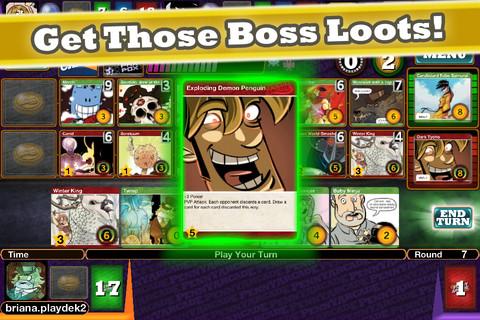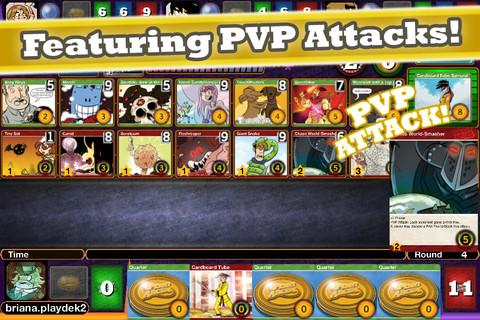- Wondering how to get Monopoly GO! free rolls? Well, you’ve come to the right place. In this guide, we provide you with a bunch of tips and tricks to get some free rolls for the hit new mobile game. We’ll …
Best Roblox Horror Games to Play Right Now – Updated Weekly
By Adele Wilson
Our Best Roblox Horror Games guide features the scariest and most creative experiences to play right now on the platform!The BEST Roblox Games of The Week – Games You Need To Play!
By Sho Roberts
Our feature shares our pick for the Best Roblox Games of the week! With our feature, we guarantee you'll find something new to play!Type Soul Clan Rarity Guide – All Legendary And Common Clans Listed!
By Nathan Ball
Wondering what your odds of rolling a particular Clan are? Wonder no more, with my handy Type Soul Clan Rarity guide.
Penny Arcade The Game: Gamers vs. Evil Review
It is wholly unsurprising that much-loved gaming webcomic Penny Arcade should have inspired a video game franchise. It is perhaps less well known that it also lent its name and art to a deck-building card game called Gamers vs. Evil. Now those two worlds collide, as developer Playdek has released an iOS version of the card game.

More Gabe and Tycho is always a good thing
It is wholly unsurprising that much-loved gaming webcomic Penny Arcade should have inspired a video game franchise. It is perhaps less well known that it also lent its name and art to a deck-building card game called Gamers vs. Evil. Now those two worlds collide, as developer Playdek has released an iOS version of the card game.
In deck building games, you start with some basic resources and use them to buy cards to add to your deck. Gamers vs. Evil has two such resources, tokens and power, which are used to buy “gamer” cards and subjugate “evil” cards respectively from a random selection that changes each game. The former tend to be more powerful, but the latter are worth points toward victory, lending a nice twist to the strategy. If you can gather enough of a resource from your hand it can be used to defeat a boss, which yields a random super-powerful card to your deck.

Right from the loading screen, you’re not going to be allowed to forget that this is a Penny Arcade game. The art is everywhere, players take on the roles of a recurring character from the strip, each with a different starting hand and special power, and all the cards are named after well-worn tropes from the comic. With Playdek’s usual interface wizardry very much in evidence, it’s a delightful looking thing full of vibrancy and endearing humour.
Mechanically though, the choice of the fashionable deck-building genre seems a poor fit. Many cards just offer more power or tokens regardless of what character or situation they’re named after. The game communicates no real sense that you’re somehow inhabiting the bizarre world of the strip: without the artwork, it could be a game about almost anything.
This is a common complaint with the genre, but in most other respects, Gamers vs. Evil breaks pleasingly away from convention. The split in card types and their asymmetric effects adds some interesting choices, as do the boss fights. Instead of the usual low interaction, you get to hit other players with PvP attacks for a variety of effects such as forced discards or the accumulation of negative scores, and they get to defend themselves if they have the right cards.
This makes it a lot more fun than some of its close relatives to play with more than two, especially once the PvP effects start flying. Helpfully the app caters for up to four players in any mix of human or three levels of AI, the hardest of which seems a pleasingly tough nut to crack. There’s asynchronous network play too, implemented with Playdek’s near-legendary skill with this feature.

Another unusual thing about Gamers vs. Evil as far as deck builders go is that there are relatively few ways you can thin your deck of accumulated cards. Usually when you start to accumulate more powerful effects, you want to get rid of the earlier, weaker cards; but here it’s not so easy. And the victory point values on some cards make it less desirable to do so.
This is a double-edged sword. On the one hand it makes the game gloriously, engagingly chaotic and unpredictable as befits its goofy theme. On the other it can be very difficult to plan any kind of overall strategy. This latter issue is exacerbated by a disappointingly small range of card effects on offer. Finding card combinations and tuning your deck to maximise your chances of drawing cards you can synergise is a key part of the appeal of deck builders, but Gamers vs. Evil makes it awkward.
I’m not a particular fan of either Penny Arcade or the deck builder mechanic; I’ll enjoy either if I come across them, but wouldn’t seek them out. But while combining this particular theme and genre doesn’t really make all that much sense, this is a fun game and Playdek have built a great interface around it. It’s quirky, unusual and oddly addictive to quickly burn through hand after hand against AI opponents. And when that gets tired, the excellent asynchronous mode should ensure you’re playing against friends well into the future.

The good

The bad
More articles...
Monopoly GO! Free Rolls – Links For Free Dice
By Glen Fox
Wondering how to get Monopoly GO! free rolls? Well, you’ve come to the right place. In this guide, we provide you with a bunch of tips and tricks to get some free rolls for the hit new mobile game. We’ll …Best Roblox Horror Games to Play Right Now – Updated Weekly
By Adele Wilson
Our Best Roblox Horror Games guide features the scariest and most creative experiences to play right now on the platform!The BEST Roblox Games of The Week – Games You Need To Play!
By Sho Roberts
Our feature shares our pick for the Best Roblox Games of the week! With our feature, we guarantee you'll find something new to play!Type Soul Clan Rarity Guide – All Legendary And Common Clans Listed!
By Nathan Ball
Wondering what your odds of rolling a particular Clan are? Wonder no more, with my handy Type Soul Clan Rarity guide.







